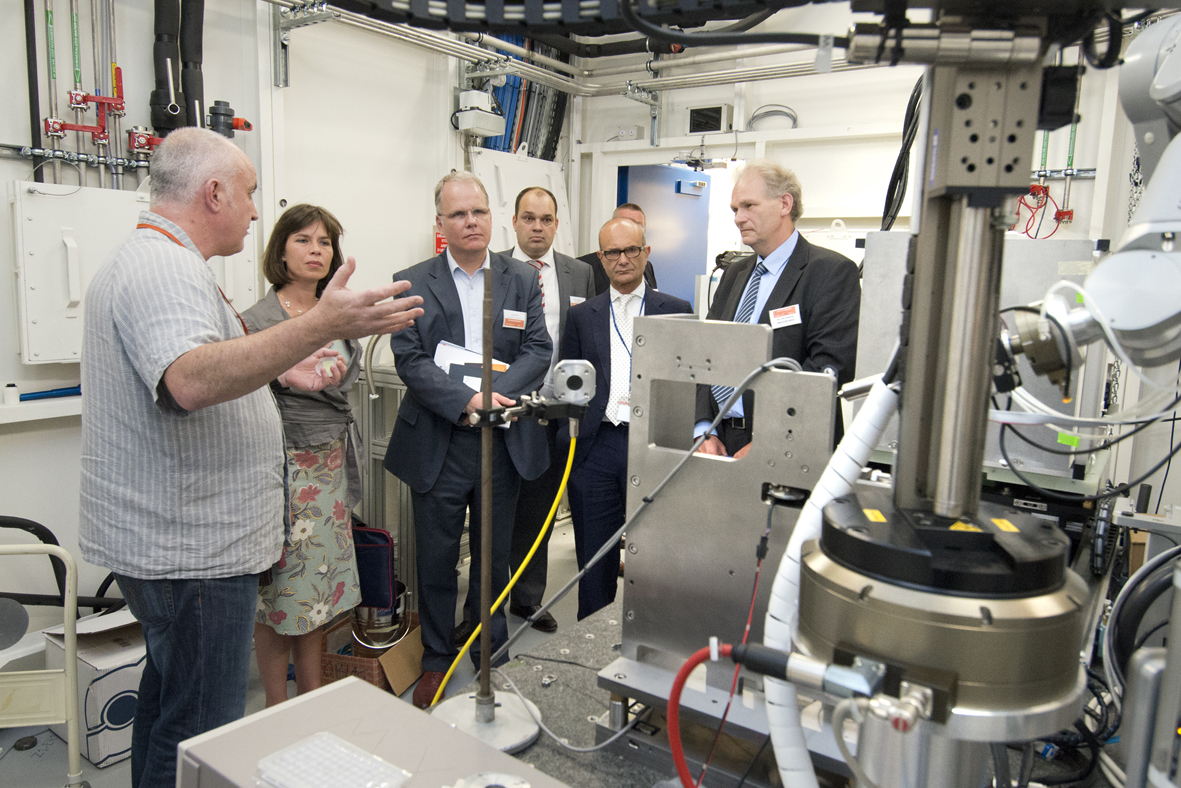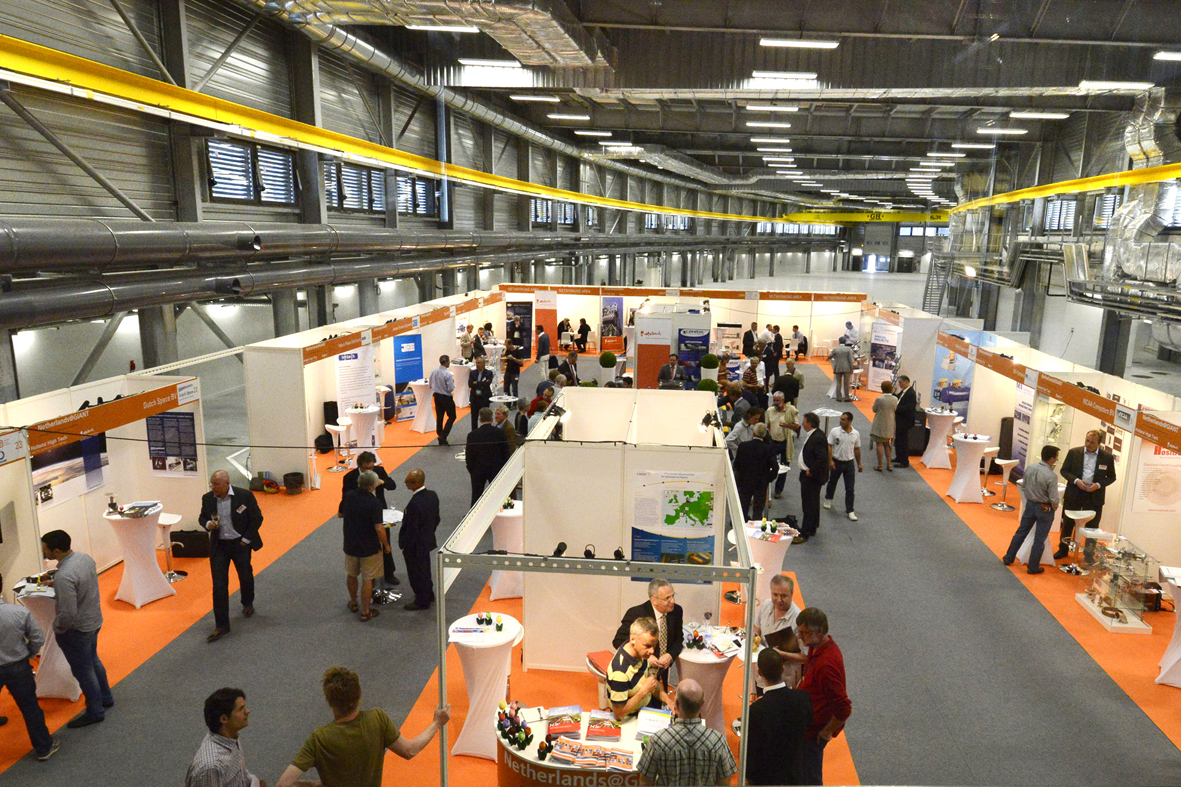- Home
- News
- General News
- ESRF hosts Matchmaking...
ESRF hosts Matchmaking between Dutch industry and Grenoble R&D companies
28-06-2013
From 25-27 June, in the presence of the Dutch Ambassador and other prestigious guests, more than 20 hi-tech companies from The Netherlands displayed their products and expertise in the newly inaugurated Belledonne experimental hall of the ESRF. The event is part of the Netherlands@GIANT initiative launched by the Netherlands Organisation for Scientific Research (NWO) to facilitate contact between Dutch companies and R&D partners from the GIANT Innovation Campus in Grenoble.
Share
The three days of Netherlands@Giant provided numerous opportunities for the representatives of Dutch high-technology businesses and Grenoble-based science and innovation leaders to meet, exchange ideas and generally get to know each other better in an informal Big Science environment.

Sean Mc Sweeney from the ESRF Structural Biology Group explains the next generation of sample handling and beamline automation at the new end station ID30-1. Next to him, from left to right, Odilia Knap, Louis Beyer, Barry van Sloten, Francesco Sette and Rob Klopping.
Orange and white stands were erected in the ESRF's brand new Belledonne experimental hall, directly under the viewing gallery of the future Visitor Centre, and soon to be home to the extensions of beamlines ID31, ID32 and ID01. It is the first time the ESRF has opened its doors to an event of this type. In doing so, it aims to honour and promote relations between one of its member countries and local industry.

A view of the industrial exhibition in the new Belledonne Hall, taken from where the future ESRF Visitor Centre will be located as of this autumn.
"It's a real privilege to exhibit inside this iconic building", says Martine Augrandjean from the Netherlands Business Support Office. "It’s an excellent opportunity to promote fruitful interaction. The organisers have struck a good balance between informal exchanges and talks and presentations."
Business match-making sessions
One novel initiative involved match-making local companies with the Dutch exhibitors. For Jan Van Eekelen, representing MI-partners, a Dutch company that develops high-end mechatronic applications, "This event gives us the chance to bridge the gap between different industrial sectors that often operate in parallel. For example, we are known in the semi-conductor industry but less so in the world of synchrotron radiation, although our technology is just as relevant for this sector. Here, we have become visible to a whole new scope of partners."
ESRF scientists and engineers grasped the opportunity to nip next door for on-site exposure to new products and niche technology relevant to their field of activity. "It's time-saving to discover different design solutions through events of this type", says Keith Martel, engineer in the ESRF's mechanical engineering group. "One of the difficulties in design engineering is staying up to date with new technology."
The Dutch delegation was composed of Ed Kronenburg, Ambassador of the Netherlands to France, Odilia Knap, Director for Innovation in the Dutch Ministry of Economic Affairs, Eric van Kooij, Attaché for innovation in the Dutch Embassy in Paris, Louis Beyer from the Dutch Ministry of Economic Affairs, and Barry van Sloten, Director General of Grontmij, the prime contractor for the EX2 buildings, through their French daughter company GINGER.
Knowledge-intensive top sectors
The Dutch government's industry policy is centred around nine knowledge-intensive top sectors that each have a high R&D intensity and strong export orientation. One of these sectors is the High Tech Systems & Materials and includes advanced instrumentation for Big Science.
The eight institutes of the GIANT Innovation Campus foster the international visibility and attractiveness of Grenoble by supporting programmes in higher education, frontier science and innovation. Through GIANT, they create opportunities for scientists, engineers and technologists from academia and industry. The ESRF is a founding member of the GIANT alliance together with CEA-LETI, CNRS, EMBL, GEM, INP-G, ILL and UJF.
The Netherlands and the NWO have a long-standing relationship with Grenoble, not only as very active and supportive funding bodies of the ESRF and EMBL but also as partners in initiatives like the international High-Magnetic Field Laboratory network and the Partnerships for Structural Biology (PSB) and Soft Condensed Matter (PSCM). The Dutch-Belgian beamline DUBBLE, operating at the ESRF since end 1998, is another example of this collaboration.
Netherlands@Giant follows on from the very successful Holland@CERN event in 2010. The organisers are keen to see the event perpetuated in the future, with the possible involvement of other Big Science structures to host the event.
Follow this link to learn more about this event and future Netherlands@ events.
Text by Kirstin Colvin
Top image: The successful event brought much interest from both inside and out the ESRF.



